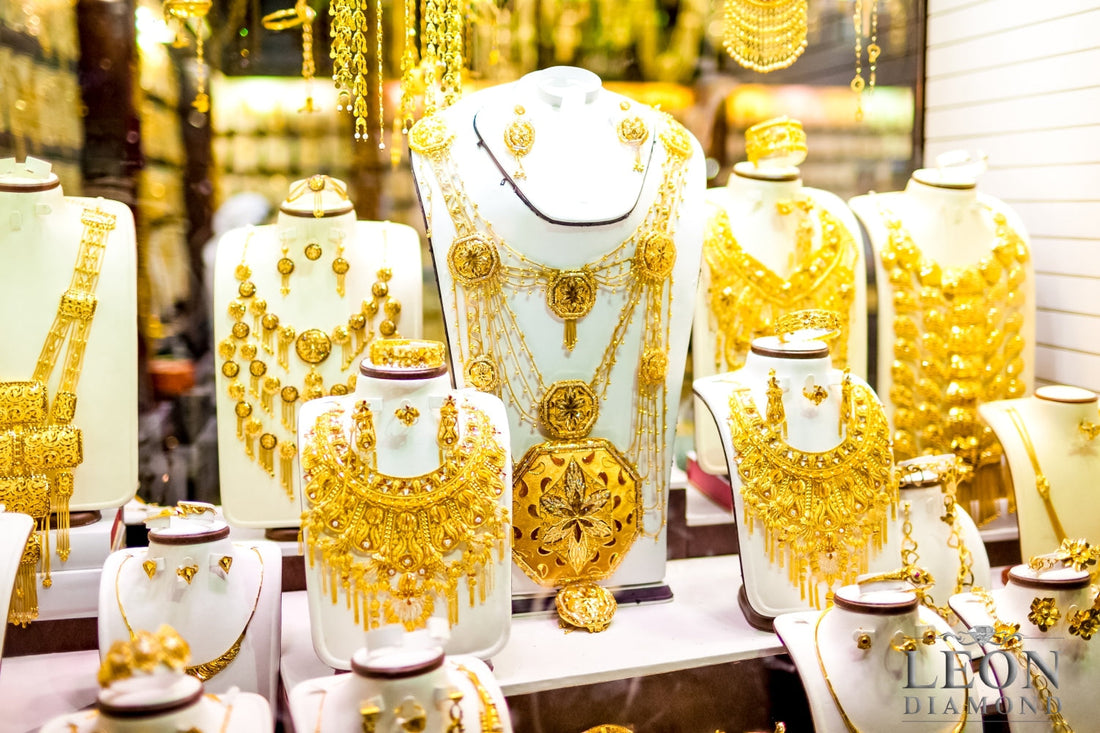
The Role of Jewelry in Ancient Egyptian Culture
Share
In ancient Egypt, jewelry was far more than adornment; it was a vibrant expression of spirituality, status, and artistry that permeated every facet of society. From pharaohs donning gold collars to farmers wearing faience beads, these artifacts embodied divine protection, social hierarchy, and cultural identity. Crafted with exquisite materials like gold and lapis lazuli, jewelry connected wearers to the gods and the afterlife. In 2025, these treasures, preserved in museums, continue to inspire awe and modern designs.
This guide explores the profound roles jewelry played in ancient Egyptian culture, revealing its enduring legacy of beauty and meaning.
Spiritual Significance: Jewelry as Divine Protection
Jewelry in ancient Egypt was a spiritual talisman, believed to offer protection and divine favor. Amulets, such as scarabs symbolizing rebirth or the eye of Horus warding off evil, were worn by all classes. The Book of the Dead prescribed specific amulets, such as red jasper for Isis's girdle tie, which was placed on the mummies' throats for afterlife safety. Gold, linked to the gods' flesh, and lapis lazuli, representing the heavens, enhanced spiritual potency (Metropolitan Museum of Art). This role underscores jewelry's function as a bridge to the divine.
"You have your blood, O Isis; you have your power, O Isis; you have your magic, O Isis. The amulet is a protection for this Great One, which will drive away whoever would commit a crime against him."
—Book of the Dead, Spell for an Isis-knot amulet
Social Hierarchy: Jewelry as a Status Symbol

Jewelry vividly reflected Egypt's stratified society, distinguishing elites from commoners. Pharaohs and nobles wore opulent gold pectorals and broad collars, often inlaid with turquoise, which signaled their divine authority (British Museum). Commoners used affordable faience or glass beads, yet still valued adornment. Scholarly analysis confirms that gold's association with the sun god Ra elevated its elite use. Military honors, like the "Golden Fly" pendants awarded to Queen Aahhotep, further tied diamond jewelry to power, reinforcing social distinctions through visible splendor.
"Thy members are of silver-gold, thy head is of lapis lazuli, and the crown of thy head is of turquoise. Thou art one of millions of years.”
—Inscription from the Papyrus of Ani, Book of the Dead
Artistic Craftsmanship: Materials and Techniques
Ancient Egyptian jewelers were master artisans, employing advanced techniques like filigree, granulation, and inlay to craft intricate designs. Gold, mined in Nubia, symbolized eternity, while imported lapis lazuli and carnelian added vibrant symbolism. Faience, a type of glazed ceramic, mimicked precious stones to increase accessibility. Tomb scenes depict artisans drilling beads with bow drills, showcasing technical skill. These methods, blending aesthetics with meaning, highlight jewelry's role as a pinnacle of Egyptian artistry.
Daily Life: Jewelry in Fashion and Function
Jewelry was integral to daily Egyptian life, serving both fashion and protective roles. Men and women wore earrings, bracelets, and beaded necklaces featuring lotus or papyrus motifs, which symbolized fertility. Even children adorned simple amulets for protection. Unlike ceremonial pieces, daily jewelry was practical, with faience beads mimicking costly stones for affordability. Tomb reliefs depict layered necklaces as a fashion statement, a trend echoed in 2025's bold styles, illustrating the role of jewelry in personal expression and cultural aesthetics.
"Egyptians adorned themselves in a variety of embellishments, including diamond rings, earrings, bracelets, pectorals, necklaces, crowns, girdles, and amulets."
—American Research Center in Egypt, Egyptian Jewelry: A Window into Ancient Culture
Funerary Practices: Jewelry for the Afterlife
In funerary contexts, jewelry ensured the deceased's protection and status in the afterlife. Heart scarabs, placed over the heart, were critical for the Weighing of the Heart Ceremony, countering separation from the soul. Tutankhamun's tomb, laden with gold masks and amulets, exemplifies this practice. Amulets inscribed with spells from the Book of the Dead safeguarded the journey to eternity, reflecting the essential role of jewelry in Egypt's obsession with immortality and divine judgment.
"I am the benu, the soul of Ra, who guides gods to the Netherworld when they go forth. The souls on earth will do what they desire, and the soul of [the deceased] will go forth at his desire.”
—Book of the Dead, Spell 29B, often inscribed on heart-shaped amulets to guard the heart in the Weighing of the Heart ritual
Historical Context and Universal Adoption
Ancient Egypt, spanning from the predynastic period to Roman times, was a stratified society where jewelry served as a unifying element across genders, generations, and classes.
|
Social Class |
Typical Jewelry |
Materials |
Purpose |
|---|---|---|---|
|
Pharaohs/Nobles |
Gold collars, pectorals, diadems |
Gold, lapis lazuli, and turquoise |
Status, divine connection |
|
Commoners |
Bead necklaces, simple rings |
Faience, colored glass, copper |
Adornment, protection |
|
All Classes |
Amulets (scarabs, ankhs) |
Various, often faience |
Spiritual protection |
Iconography: Jewelry in Art and Symbolism
Jewelry was a prominent motif in Egyptian art, symbolizing power and divine favor. Wall paintings and sculptures, like those in the Valley of the Kings, depict pharaohs with elaborate collars, reinforcing their sacred status (Louvre Museum). Symbols like the ankh (life) and wedjat eye (protection) adorned both jewelry and reliefs, linking adornment to cosmic order. This integration, supported by archaeological evidence, highlights the significance of jewelry as a visual language, amplifying Egypt's cultural and religious narratives through artistic expression.
"In wearing gold necklaces, and bracelets, and brooches, and anklets, they exceed all mankind."
—Herodotus, Histories II.37 (on how Egyptians depicted themselves adorned in art and reliefs)
Gender Equality: Universal Adornment Across Genders
Unlike many ancient societies, Egyptian jewelry transcended gender norms, with men and women wearing similar styles. Men sported broad collars and signet rings, while women favored layered necklaces, as seen in noblewomen's tomb depictions. Archaeological evidence shows minimal design differences, mainly in scale. This egalitarian approach, unique for its time, underscores jewelry's role as a shared cultural practice, uniting Egyptians in their pursuit of beauty and protection.
"Both men and women adorned themselves with earrings, bracelets, rings, necklaces, and neck-collars that were brightly colored. Those who could not afford jewelry made from gold or other stones would make their jewelry from colored pottery beads."
—History on the Net, Clothing in Ancient Egypt
Economic Impact: Trade and Prosperity

Jewelry production drove Egypt's economy through extensive trade networks. Gold was locally mined, but lapis lazuli and silver were imported from Mesopotamia and the Mediterranean, enriching cultural exchanges (Museum of Jewelry). These networks, facilitated by the Nile, supported Egypt's prosperity, with jewelry as a significant trade item (Britannica). Pharaohs' gifts, such as inscribed oyster shells for soldiers, further integrated jewelry into Egypt's economic and political systems, highlighting its role in sustaining the country's global influence.
“The earth is dug into for riches, when life demands gold, silver, silver-gold and copper, and in other places for luxury, when gems and colours for tinting…”
—Pliny the Elder, Natural History (Book 33)
Honoring the Artistry of the Ancients
Jewelry in ancient Egyptian culture was a multifaceted emblem of spirituality, status, and artistry. From protective amulets to opulent collars, it shaped religious rituals, social hierarchies, and daily life. Its craftsmanship and symbolism, preserved in tombs and art, reflect a civilization's devotion to beauty and eternity. In 2025, this legacy inspires modern designs, with LEON DIAMONDS honoring Egypt's heritage through exquisite pieces that capture the enduring allure of ancient adornment, connecting past and present in a celebration of cultural brilliance.
Frequently Asked Questions
What did jewelry mean spiritually to the ancient Egyptians?
For them, jewelry wasn't just decoration; it was deeply spiritual. Pieces like scarab amulets were believed to offer protection and attract the favor of the gods, keeping the wearer safe both in life and beyond.
How could you tell someone's social status by their jewelry?
Jewelry was a clear status symbol. The wealthy and powerful often wore gold collars and vibrant gemstone pectorals, while everyday people wore simpler pieces made from materials like faience. What you wore said a lot about who you were.
What materials did ancient Egyptians use in their jewelry?
They loved using gold, lapis lazuli, turquoise, and faience. And they didn't just string things together; they employed advanced techniques like filigree, inlay, and granulation to create intricate and stunning designs.
Why did people wear jewelry every day in ancient Egypt?
Jewelry played a dual role, being both stylish and protective. Everyday pieces often featured meaningful symbols, such as lotus flowers, believed to bring spiritual safety and beauty to the wearer.
What role did jewelry play in ancient Egyptian funerals?
Jewelry was just as important in death as in life. Items like heart scarabs and protective amulets were buried with the dead to guide and guard them on their journey through the afterlife.
How is ancient Egyptian jewelry still influencing design today?
Modern designers still draw inspiration from Egypt's timeless motifs, think scarabs, lotus flowers, and sun disks. These ancient symbols are now reimagined in contemporary pieces that honor the past while embracing modern craftsmanship.
Modern Legacy: Inspiring Contemporary Design
The legacy of ancient Egyptian jewelry endures, captivating designers of 2025 with its bold motifs and vibrant colors. Scarab amulets and lotus patterns inspire luxury collections, which are preserved in institutions such as the Metropolitan Museum of Art. Modern pieces echo Egypt's emphasis on symbolic adornment, blending ancient aesthetics with cutting-edge techniques. Leon Diamond channels this heritage, crafting jewelry that marries timeless elegance with contemporary sophistication, ensuring ancient Egypt's cultural impact resonates in today's world.
